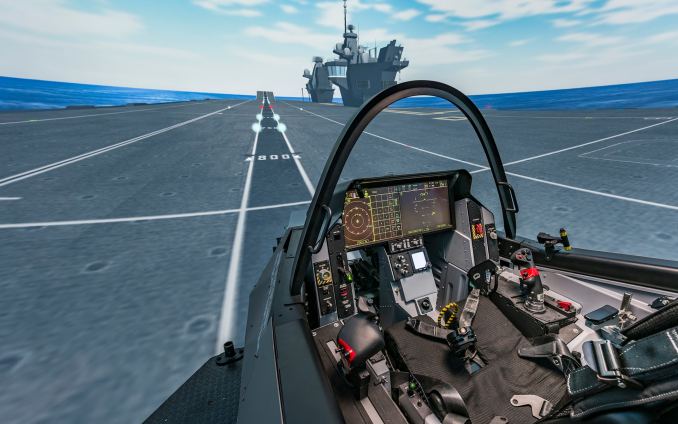

VR Landing on Queen Elizabeth Class carrier 
Virtual reality (VR) is now reshaping the training environment for F-35, enabling improved aircraft familiarisation and task training for Air Force ground crews prior to the widespread rollout of the fifth-generation platform.
VR for the US Air Force
The USAF reported that two new virtual reality F-35 simulators are currently under construction at Hill air force base. The highly advanced systems are surrounded by an 11 foot tall translucent dome, positioned in a blackened room to ensure pilot shave a realistic sensory experience, while 25 projectors display a 365-degree image around them while in “flight.”
The high-definition image is so realistic, pilots can feel like they’re moving even though their simulator cockpit is stationary.
The F-35 pilots assigned to Hill’s 388th and 419th Fighter Wings rely on simulator training to augment actual training sorties and spend 3-6hours on the ground in virtual flight each month.
As software upgrades are added, the simulators will allow pilots to fly virtual war games with other pilots around the globe. The new simulators will be completed this summer, bringing the total number at Hill to six. The simulators are operated and maintained by 13 simulator pilots and technicians from Lockheed Martin and BAE Systems.
The VE Studio toolkit to produce the high-fidelity 3D environment, and physics-based simulation models. This application is driven by AAI’s realistic aircraft simulation software and managed by an advanced instructor operator station for student monitoring and scenario management.
VR for the Royal Australian Air Force
The Royal Australian Air Force reported that KBRwyle developed the VR prototype to support higher capacity training of F-35 support crew. The prototype was developed in less than a month using the company’s Canberra-based technical team, demonstrating the depth of expertise in its Australian capability. The global nature of the F-35 program has enabled KBR’s training capability to help transform the Australian industry through the global collaboration used to support the training program developed by KBRwyle.
KBRwyle brought this knowledge back to Australia and has utilised it to further enhance its delivery to the F-35 program. This has also enabled KBRwyle to expand its training offerings for other ADF programs, including:
- Training design, development and delivery for acquisition and sustainment of the ARH Tiger helicopter;
- Development of the ARH Virtual Avionics Systems Trainer;
- Development of the MRH-90 Virtual Systems Trainer;
- Development of the Landing Helicopter DockShip Walk-Through Computer Model;
- The development of LHD training and ongoing delivery.
VR for British Royal Navy
Royal Navy pilots to fly F-35 on a simulator built by BAE Systems, which offers an immersive environment allowing engineers and technicians to test just about every system and situation a pilot might encounter when landing on or taking off from the new Queen Elizabeth Class aircraft carrier. The simulator adjusts to the pitch and roll of the oceans, to air turbulence or potential failures in the plane – anything that will have an impact on a pilot’s ability to operate and land.
“Real”fighter jet trials from the new Queen Elizabeth Class carrier started this year after teams have gathered the extensive evidence and data required from simulated flights.
© 2018 – 2019, LM Publications. © GDC and www.globaldefensecorp.com. Unauthorized use and/or duplication of this material without express and written permission from this site’s author and/or owner is strictly prohibited. Excerpts and links may be used, provided that full and clear credit is given to www.globaldefensecorp.com with appropriate and specific direction to the original content.






Be the first to comment